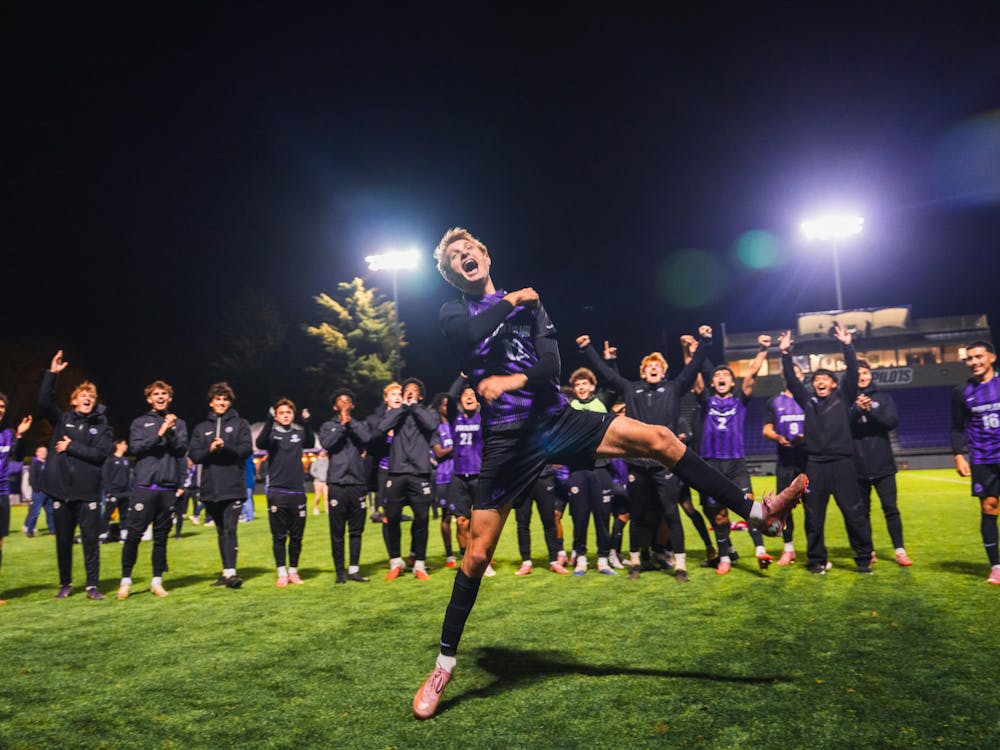New NCAA policy on paying athletes raises questions for UP Athletics
By Bruce Garlinghouse Staff Writer garlingh13@up.edu
In the last couple of years, the term "pay-for-play" has gathered growing relevance in college sports in the wake of several scandals involving athletes taking illegal benefits.
Many argue offenders were pushed to violate NCAA rules because the amount of time committed to their sport didn't allow them to have jobs for extra money.
The NCAA responded with an unprecedented vote granting conferences the option of allowing universities to award a stipend of up to $2,000 to cover the "incidental costs" of a college education that go beyond tuition, room and board and the cost of books. In other words, spending money.
The West Coast Conference has not yet made a decision whether WCC schools, including UP, will permit additional stipends for athletes. But UP Athletic Director (AD) Larry Williams said he and other AD's are struggling with where they would find the money for a stipend program if given the green light.
"The difficulty right now is how do we fund it," Williams said. "Can you do it, how will you do it? Do we have to cut checks for the kids? We're all struggling with how we do it, the mechanics, the philosophy behind it."
University President Fr. Bill Beauchamp, C.S.C., who sits on the NCAA Board of Directors, said he voted against the $2,000 payment option, but not because he doesn't see a gap between a full scholarship and the actual cost of attending college.
"The reason I voted against is because it can become a huge amount when multiplied through all the sports, and I do struggle with the issue of pay-for-play," he said.
With the $2,000 payment option, smaller schools will have to compete for recruits against larger schools with bigger budgets.
Williams added that there are already opportunities in place for student-athletes who need financial aid, such as a Pell grant, which any student, athlete or not, can apply for and receive up to $5,500 a year.
In addition, the federal government created the Student Athlete Opportunity Fund (SOAF), which is intended to provide direct benefits to student- athletes and their families as determined by the conference.
Is Basketball the answer?
According to Williams, the athletic department's largest revenue streams are ticket sales and donations.
According to the Equity in Athletics Disclosure Act (EADA) report, UP generated $12,167,639 in revenue (some of which was a University subsidy) last year, an increase of $1,937,113 from the year before.
Despite UP leading the nation for the last couple of years in attendance at women's soccer games, Williams said men's basketball, which generated $2,060,816 last year, is the primary money driver.
"Soccer is in another language," he said. "We have to teach people this other language. Everybody speaks college basketball. We have so much potential to increase our revenue and decrease our dependency on University subsidies by having our basketball team be more successful."
The men's basketball team has seen recent success, recording three
20-win seasons in the last three years and increasing revenue almost every year since 2007.
Williams said the University is looking to enhance game day experiences in order to fill seats.
"We have a great thing going on here with soccer, but there is nothing unique or palpable for basketball," he said. "What we need to do is fill that arena with engaged fans and in order to do that we need to offer different amenities that make it comfortable and enticing to come to the games."
The University has plans to diversify concessions and recently installed 12 flatscreen televisions for fans to watch while they are at concession stands. The new video board installed last year was also part of that plan.
Adding preseason games against top-tier programs has allowed UP to tap into a new revenue stream. Last year, the Pilots signed a contract with the University of Kentucky to play three games over the course of three seasons. The two teams met last year in the Rose Garden, and this year's matchup resulted in an 87-63 loss in Kentucky's Rupp Arena. The final game will also be in Kentucky because they paid UP to play away.
Williams said it is common for large programs to pay teams like UP to travel and play them. Although it is an additional source of revenue, Williams said "being bought" isn't always in the University's best interest.
"We want to build community and enhance awareness and it's hard to do that when they are playing on the East Coast," he said. "We would rather play big games here."
UP Athletics, most WCC schools lose money
According to
reports submitted as required by the EADA, UP's athletic department has lost money every year since 2009.
A $2,000 stipend granted to the UP's current 259 student-athletes would mean $518,000 in expenses added to the average $9 million the athletic department has spent every year since 2003.
Williams said he expects UP would to have to fund a stipend program if the WCC were to allow it.
"Relative to this particular iteration, yeah, I would expect that we would participate and figure out how to get this one done," Williams said. "We all want to compete. It doesn't make much sense to be at the Division 1 level if you're not going to compete."
According to Williams, there are approximately two dozen schools whose athletic departments turn a large profit, generally schools with large football and basketball programs.
"We don't typically get to participate in media revenue streams, so we're competing against schools that have quite an advantage over us from an investment standpoint in that they can draw media revenue, bowl payouts and sources of revenue that aren't available to us," Williams said.
For example, the Longhorn Network, a recent television deal between the University of Texas and ESPN, will provide nearly $11 million to the school each year.
According to Williams, the University of Portland pays television networks such as Fox Sports Net to broadcast its games, citing exposure as justification for the expense.
"It's never been a revenue- positive effort," Williams said. "It's to build awareness and to share our story."
Aside from Gonzaga, Brigham Young University and the University of San Diego, every school's athletic department in the WCC has lost money since 2009.
Gonzaga's basketball program helps it stay in the black due to high ticket and jersey sales that helped generate $6,128,191 last year.
BYU and USD are the only schools in the WCC that field football teams, adding more than $1 million in revenue for USD and more than $15 million for BYU.
Reveno's take
Men's head basketball coach Eric Reveno sees a stipend program as a step in the right direction.
"Part of a scholarship is that they get money in their pocket, not just tuition, room and board and books," Reveno said. "To limit a scholarship in that way is over restrictive."
Reveno said providing a stipend to student-athletes creates a new element in the recruiting landscape, but said he doesn't think it will seriously alter it.
"This kind of recruiting is already used, like being able to provide charter planes for trips, that's essentially extra money," he said. "I like to think an athlete will choose a school based on an experience, not because they'll get an extra $2,000."
Senior point guard Eric Waterford, on the other hand, said it would be an enticing addition.
"Any player would seriously consider going to a school that was going to give you an extra $2,000 over a school that wouldn't. Especially if the decision between those two schools is close," he said.
Williams said he thinks the NCAA's decision will undermine the amateurism of college athletics.
"I firmly believe that the opportunity to have a fully funded educational experience is far greater than what I (an athlete) am giving to the institution," he said
Reveno said he doesn't believe a stipend will curtail the taking of illegal benefits, which is arguably the driving force behind the decision.
"There is just normal human greed. I don't think it will solve that problem," Reveno said. "That money is available now if they really need it."
Expenses
While collegiate athletic programs generate millions in revenue, most accumulate more in expenses. Last year, UP's expenses reached $12,167,639.
Basic operating expenses including lodging, transportation, uniforms and equipment for players, coaches and other team members reached $1,776,113 last year.
Other expenses include coaches' salaries, recruiting expenses, student-athlete related financial aid and institutional costs such as bonuses.
The men's teams' expenses totaled $5,122,285. That figure is $492,842 more than women's teams, which can be explained by the more than $200,000 men's teams tallied in operating expenses compared to women's teams and a large gap in average coaching salaries. The average salary of a men's head coach at UP is $102,024 while the average women's head coaching salary is $66,434, which could be explained by Reveno's $198,953 base salary as reported in the school's 2009 W-990 tax form. That salary, combined with Reveno's additional pay including bonuses, retirement, and what the IRS calls "other reportable compensation", brings Reveno's total 2009 compensation to $275,231, making him the second highest paid University employee after Beauchamp.
"The reason for the difference is all market-based," Williams said.
The men's teams also exceeded the women's in recruiting expenses by more than $30,000, but women's teams gave out $200,000 more than men's teams in student-athlete financial aid.
Still, many question whether or not the NCAA's decision is, in fact, pay-for-play, and if further compensation is necessary. With tuition costs on the rise and student debt exceeding credit card debt this year, many argue that an athletic scholarship is already adequate compensation for athletic participation.
Although Beauchamp acknowledged there are costs beyond a scholarship that student-athletes could struggle with, he
underscored
the benefits of a college education.
"I would like to think that a scholarship has value," he said. "Not only the money they receive as a scholarship, but after they graduate from the University there is certainly a value to a college degree for the rest of their lives which can typically add up to millions of dollars."
Full Academic Scholarship
WHAT: A full scholarship includes full coverage of tuition, room and board and books. According to UP's Out -of -Pocket Expenses Worksheet 2011-2012 on the school's website, out -of- pocket expenses for this academic year are $45,390 which excludes the cost of books and individual class fees.
TWO TYPES:
1. Head count sports- Both the men and women's basketball teams can give 13 full scholarships and volleyball can give 4.5. Williams said all three teams have given the max amount of scholarships. UP's only head count sports are basketball and volleyball.
2. Equivalency sports- All other UP sports besides basketball and volleyball can distribute a certain amount of money that is the equivalent of a certain number of full scholarships. That money can be distributed at the University's discretion.
Play-by-play breakdown
UP's largest athletic revenue streams come from ticket sales and
donations.
In 2010, UP generated $12,167,639 in revenue
Average annual expenses: just over $9 million
UP has 259 student-
atheletes
Projected total athlete
stipend: $518,000







